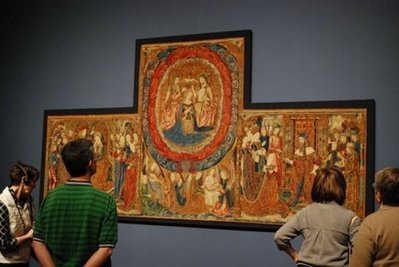French Renaissance Art Gets Royal Treatment in US

Early French Renaissance art receives the royal treatment in the first major U.S. exhibit devoted to the period which opened this week at the Art Institute of Chicago.
Frst shown in Paris, the exhibit provides a rare glimpse of the period in which late Gothic exuberance was influenced by the energy and harmony of the Renaissance.
The collection of nearly 120 exquisite objects -- including stained glass, tapestries, altarpieces, sculptures and illuminated manuscripts -- features art produced around 1500.
It was a dynamic period in which France entered an age of rapid expansion and creative energy as two young kings -- Charles VIII and Louis XII -- pursued dynastic claims and dreams of glory.
The exhibit was organized jointly by the Art Institute and the Reunion des Musées Nationaux and includes treasures loaned from dozens of museums and private collections in Europe and the United States.
"It's the result of years of research which shows that the art at the end of the Middle Ages and the art of the early Renaissance are not in opposition, but that there is a very significant continuity," said Jean-Paul Cluzel, president of the Reunion des Musées Nationaux and the Grand Palais.
"We are still in a period of profoundly religious art, but it is an art that at the same time is aesthetically ready to be part of the Renaissance."
The work incorporates the "extremely elaborate and delicate aesthetic" of the Renaissance, but has not yet adopted the humanistic philosophy and is still focused on the relationship between man and God, Cluzel told Agence France Presse.
One of the highlights of the exhibit is the golden vessel which held the heart of Anne of Brittany, who was twice crowned queen of France but asked that her heart be buried with her parents in Nantes while her body was buried in the French royal tomb at Saint-Denis.
It also includes a rare loan of Leonardo da Vinci's "Madonna of the Yarnwinder," portraits and devotional paintings by Jean Hey, known as the Master of Moulins, and a remarkable heart-shaped stained glass "The Virgin in Glory" from the Cathedral of Notre Dame in Moulins.
"This exhibition presents wonderful, precious objects that allow you to enter a sort of magical world of faith," said Martha Wolff, curator of the exhibition for the Art Institute of Chicago.
"This is a wide world of art that was conceived by really creative geniuses."
The exhibit, "Kings, Queens and Courtiers: Art in Early Renaissance France," runs through May 30.



